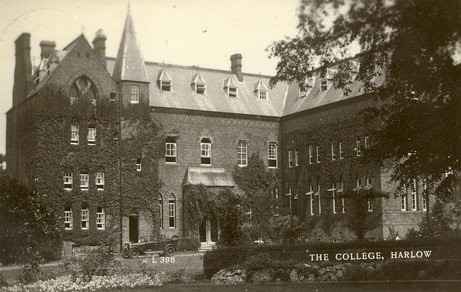Schools
Prior to the passage of the Elementary Education Act in 1880, which made it compulsory for all children aged 5 to 10 years to attend school, virtually, all education took place either in private, or Church-sponsored, schools. Three of the more significant schools in Harlow are described below.
Fawbert and Barnard's School
This London Road school may be a continuation of one founded 1802 by Montague Burgoyne of Mark Hall on Godsafe's Charity Land in High Street. Although it was initially supported by both churchmen and non-conformists, it was being run on the British system y 1811, and doctrinal disputes inevitably arose and the school was closed in 1836 although it had more than 100 pupils. That same year, John Barnard, a Harlow maltster and executor of the 1824 will of George Fawbert of Waltham Cross, used a bequest of £7,000 to build a non-denominational school in London Road. Barnard stipulated that there was to be 'no interence by the Church' in the affairs of the school, which was designed to accommodate 200 children. The pupils were to be drawn from Harlow, Latton, Netteswell, Great and Little Parndon, Magdalen and Little Laver, Sheering, Matching, and two parishes in Hertfordshire: Gilston and Eastwick. An infant school was added in 1892, a boy's classroom in 1897, a technical instruction block in 1912, and three more classrooms in 1947. It was the only school in the area equipped to teach domestic science to girls and woodworking to boys. In 1910 attendance was restricted to children who had attended a public elementary school for at least two years.
The Churchgate Street School
In the early 18th century there was a school for poor children in Hobbs Cross Road (an extension of Churchgate Street) supported by Wright's and Stafford's Charities. It seems to have been short-lived. In 1816, a group of churchmen, led by the vicar of St. Mary's, decided to build a new school because of their dissatisfaction with the non-sectarian education offered by the Fawbert and Barnard school in London Road. The school was intended 'for the children of the laborious part of the population'. In 1849, John Perry-Watlington of Moor Hall donated land and a new building in Churchgate Street.
The Prospectus of the new school promised that it would "afford to children of both sexes, of the age of seven years and upwards, residents in Harlow and the neighbourhood, a sound English Education based upon the principles of the Church, embracing: religious instruction, English taught grammatically, penmanship and linear drawing, arithmetic with the elements of geometry and algebra, the theory and practice of vocal music, history, especially of our own country, and geography, with the sketching of maps. In the girls’ school, half the day will be given to needlework. The terms including books and stationery will be, for parishioners of Harlow, six shillings, for children from other parishes twelve shillings a quarter. The children of the poor will be admitted: those of Harlow at one penny, from other parishes at two pence a week for each child. Payments to be made in advance. Application for admission to be made to the Vicar."
An infants' school was opened in 1859, in a neighbouring building owned by Perry-Watlington. The infant and mixed school amalgamated in 1923, and the school was granted 'Aided' status in 1954. It moved to new buildings in Hobbs Cross Road in 1971. The old building, described as the 'Ex-Church of England Churchgate Street School' was sold in 1973, subject to the condition that it not be converted into more than 2 houses.
St. Mary's (Harlow) College
A boys' boarding school was built by the Reverend Charles Goulden near St. John's Church in Old Harlow. It opened its doors on 29 May 1862, flourished under a succession Headmasters, and by 1905 had 65 boys and 6 masters.
The new school aimed to provide "a superior education for the sons of gentlemen and (when sufficient amounts have been obtained) to train at low charge the sons of missionaries abroad, of clergymen similarly engaged at home, as well as orphan sons of gentlemen who have been reduced in circumstances."
The 1947 decision to use Harlow as the basis of a New Town brought about the demise of St. Mary's College, in spite of the assertion in the 1962 prospectus that the buildings of the New Town "do not in any way encroach in the school grounds, nor can they be seen therefrom". Two years later the headmaster was told that the site would be required for construction of the houses in the Jocelyns estate. An effort was made to find the college a new site in Hertfordshire, but this was unsuccessful, and it was closed. All but one of the buildings were demolished in 1966. The surviving building, which had housed the Lower and Middle Remove and some staff accommodation, became part of the Memorial University Campus. Both parts of the original building were converted into faculty accommodation in 1969: St. John's House and St. John's House Cottage, but then the House was converted back to a classroom in 1998.



